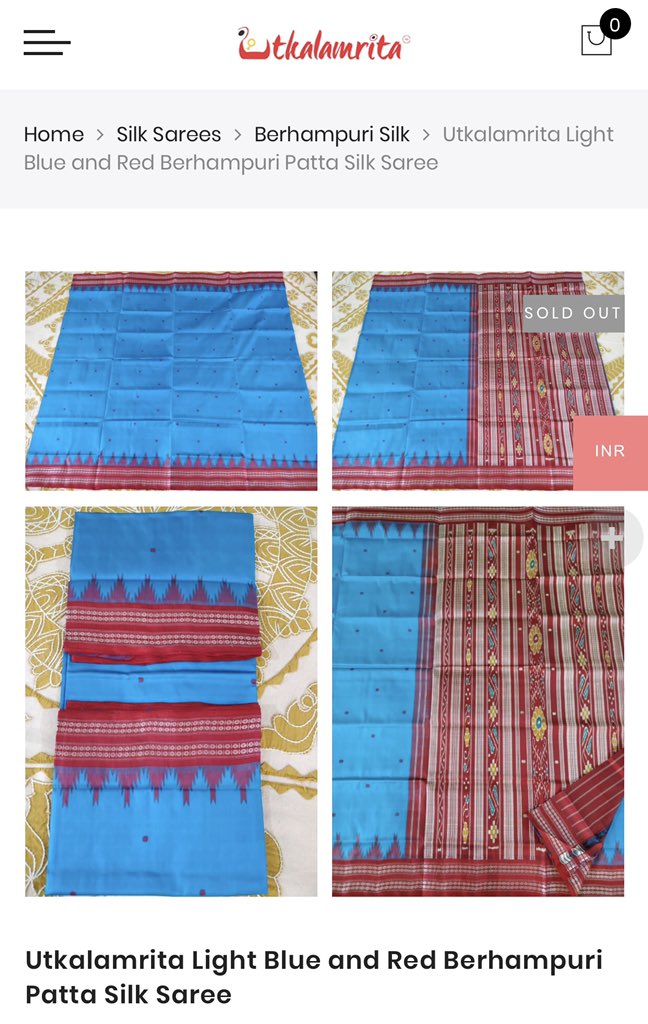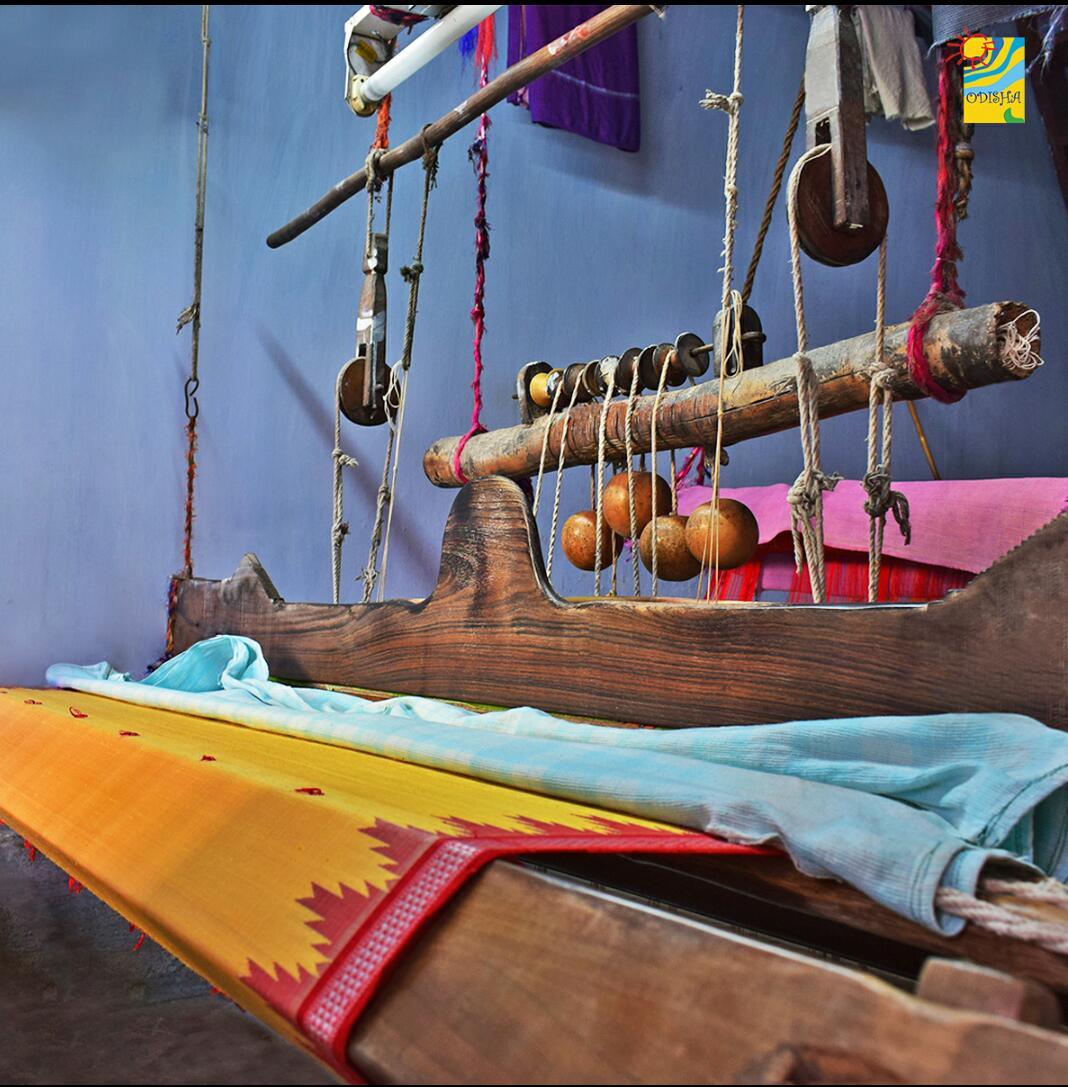Odisha has a variety of handlooms. As per records, handloom weaving in Odisha goes back to 600 BC. Some of the Odisha handlooms have earned the Geographical Indications (GI) tag.
You can read about them here- Handlooms of Odisha.
While many saree lovers know the name of Sambalpuri saree, the other names are not that well known.
Have you heard of "Berhampur Phoda Kumbha Patta and Joda"?
Berhampur is my native place. It is called the silk city of Odisha. The silk sarees of Berhampur are much in demand, especially for marriage purposes.
According to the Orissa District Gazetteer, Ganjam 1995, the craft of silk-weaving was introduced in Berhampur in the 14th Century AD by the Mohuri Kings.
GI Application No.- 220 – Berhampur Patta (Phoda Kumbha) Saree & Joda – Handicraft
Berhampur Patta
The silk city of Odisha is "Brahmapur". As many refer to it as- Berhampur, the handoom GI of this city in Ganjam district of Odisha is known as "Berhampur Patta (Phoda Kumbha) Saree & Joda".
"Patta" means silk.
This saree is popularly called - Berhampuri Silk.
Berhampur Patta (Phoda Kumbha) Saree is a special weave with a traditional and typical temple pattern that is called the "Phoda Kumbha". One weaver and one assistant weaver are needed to weave the Phoda Kumbha design. Both the sides of the Kumbha are alike. The Phoda Kumbha is prominent as lower reed counts are maintained on the border in comparison to the body. The Kumbha size varies from saree to saree- ranging from quarter inch to more than one feet. This design makes this handloom product unique and thus, it has got the GI tag.
Tie and dye Ikat designs are also woven on the anchal of some sarees.
Women wear sarees, while there are jodas for men.
  |
| Source |
— Bruce Bucknell (@Bruce_Bucknell) September 15, 2019
.#Odisha Odyssey 5:
distinguishing warp from weft
Berhampur’s handloom weavers dye and weave mulberry silk into
sarees of local designs.
Thread here:
shiny 3 ply warp (length) left
rougher 6 ply weft (width) right.#bestkeptsecret
. pic.twitter.com/Bnhl5EMXgj
.#Odisha Odyssey 6:— Bruce Bucknell (@Bruce_Bucknell) September 15, 2019
the Berhampur weavers
There are 117 weavers in
the town organised into
cooperatives to source,
market and sell the best
Oriya sarees.
Painstaking work to produce garments of beauty.#bestkeptsecret
. pic.twitter.com/5m9WTysjYE
The weavers are facing difficulties, low income, and they need support. They had hardly recovered from Cyclone Fani and now they have to face COVID-19.
The younger generation is not interested to learn the craft. Thus, the weaver numbers are dwindling. As fewer weavers are weaving, stock availability is a concern. Now, there is terrible gap between demand and supply.
Post-GI initiatives like training and market linkages are needed.
My Theme for this year's April #AToZChallenge is - the Geographical Indications (GIs) of Odisha #OdishaGI.
This is my sincere attempt to share information about the GI-Tags of Odisha.
GIs are linked with the culture, traditions, history, reputation etc of a geographical location.
GIs are linked with the culture, traditions, history, reputation etc of a geographical location.
How can we learn or know more about them? When information is shared, people can be aware.
However, we must refer to reliable sources and not be a party to misinformation.
Do follow my posts to learn more about the GIs of Odisha.You can check out my #AToZChallenge posts here.




This was an interesting read, something that we should know and weren't aware off. Looking forward to more on Odhisha
ReplyDeleteVery informative and interesting! Glad to have been introduced to this Handloom from Odisha. Amazing!
ReplyDeleteSuch traditional handloom workers put in a lot of hard work to keep the tradition alive. Of course they all our support and encouragement.
ReplyDeleteI enjoyed the technical descriptions of the berhampur sarees in your post. In the south kancheepuram silk sarees are popular. It is indeed a pity that youngsters are not interested inn the art of weaving that you speak of.
ReplyDeleteI am a all time fan of handloom sarees. I like them more than today's designer sarees. They hold an elegance. We have Paithani in Maharashtra.
ReplyDeleteInteresting post, Nice to read.
ReplyDeleteWahh, I love art and culture and I found your post interesting. Nice one, really loved to read.
ReplyDeleteI love handloom sarees and would definitely like to own one. Let me note this down. Thank you for sharing, Anita <3
ReplyDeleteNice handloom sarees,! Yeah the workers are facing a hardtime
ReplyDeleteI have heard about Berhampur sarees and love their patterns. Thanks for sharing this informative and interesting post, Anita!
ReplyDeleteKudos to the work that you have been doing in bringing Odisha to the world map. I belong to Berhampore though this one is in Bengal.
ReplyDeleteThis is an informative piece. I've always loved the variety of handlooms across the country. The designs are beautiful here.
ReplyDeleteSad to see that Berhampur handlooms are facing the same problems that many other indigenous handloom varieties are facing. Hopefully proper marketing and training support will uplift this art form too.
Thanks for this post.
All the best for the rest of the A2Z.
I have not only seen this Saree print... But also worn it and always thought it was sambalpuri print...
ReplyDeleteHappy to know about Berhampur Patta. Interestingly, sik is called as Patte in my native.
ReplyDeleteGreat initiative to bring awareness about GI tags. Kudos to your efforts, Anita!
Looking forward to more posts on Odisha textiles.
Hope the cottage industry remains safe during this lockdown. Take care!
Wonderful! We are a talented lot of diversity, not only in culture but also craft. Glad to know about the Berhampur patta saree.
ReplyDeleteThe saris look so beautiful! WOW!
ReplyDeleteBeautiful descriptions on sarees but remain silent on Jodas. Why?
ReplyDeleteThank you for your question & feedback.
DeleteNeed to be more aware to share.
Will ensure information in the publication.
I like to wear sarees. I have never worn berahampur saree. But i'm glad to know about these.
ReplyDelete